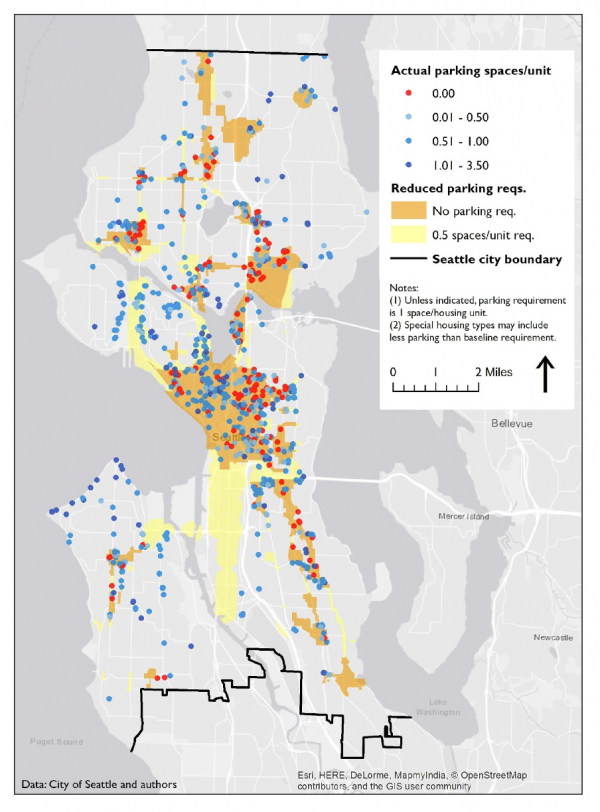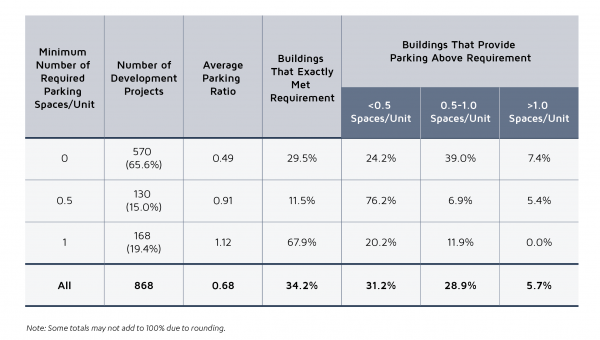
How Developers Respond to Parking Reform
Reducing minimum parking requirements can help alleviate urban housing crises
Most U.S. cities require residential developers to provide one or more parking spaces with each housing unit they build. In many cases, these laws result in more parking than housing consumers want or need. An oversupply of parking can lead directly to higher housing costs, inefficient land uses, and more vehicle ownership and driving. As such, oversupplying parking harms the environment, reduces housing affordability, and thwarts efforts to improve social equity.
Realizing these downsides, a growing number of cities are reforming their parking policies to let developers provide fewer parking spaces. For researchers, an important question is how developers react to these changes: When and where do they provide less parking, when the city gives them the option of doing so? We recently examined this issue in Seattle, after the city reduced its off-street parking minimums. We found that developers built less parking after this zoning reform was enacted. We have reason to think, moreover, that this allowed Seattle to increase its housing production and discourage reliance on automobiles.
Parking Requirements and Land Development
Researchers generally agree that traditional zoning has caused large swaths of urban America to be devoted to parking. What we know less about is how the built environment would look if traditional zoning was changed, and no longer included parking requirements: Would all housing units have less parking, or would we see a wider variety of parking/housing combinations — for instance, some homes with ample parking but also many apartments or townhomes with little or none?
One way to answer this question is to estimate what developers of existing buildings would have done if the zoning requirements didn’t exist. Typically, researchers make these estimates by comparing the number of parking spaces on a site to the number the zoning regulations required. If developers build only to the zoning minimum (e.g., they build only one space per unit when the zoning calls for one space per unit), we can infer that, at least in the developers’ judgment, there is no demand for additional spaces. We often consider this suggestive evidence that the parking requirements are set too high. If developers try to build less than the minimum — by applying for incentives, variances, and other modifications of zoning code minimums, that constitutes even stronger evidence that the parking requirements are set too high. Parking requirements that are too high suggest that cities are forcing developers to build parking that people don’t want, at the cost of housing units that people do want.

Parking requirements that are too high suggest that cities are forcing developers to build parking that people don’t want, at the cost of housing units that people do want.

Most studies that employ this method of assessing parking requirements find that minimum parking standards constrain development in big cities. But these studies are limited by being counterfactual estimates: We are guessing what would have happened under different zoning. It is preferable to have an actual zoning regulatory change occur, and then observe what happens. Seattle offers an opportunity to do that.
Seattle’s Parking Policy Reforms
In 2012, concerns about housing scarcity led Seattle to lower its parking minimum requirements. Doing so was in line with the city’s comprehensive plan, and with regional plans that emphasized connecting denser growth centers with more public transit options. Before this reform, Seattle had required residential developments across the city — except for downtown and some special housing types — to provide at least one parking space per housing unit. The 2012 reforms changed this requirement in three big ways. First, the city eliminated all off-street parking requirements for multifamily housing in neighborhoods the city considered “high-density urban centers” (e.g., downtown Seattle, Capitol Hill, South Lake Union, Uptown, and the neighborhoods around the University of Washington). Second, it eliminated multifamily parking requirements in residential and non-residential uses in “medium-density neighborhood centers” (or “urban villages”) located within a one-quarter mile of a public transit stop that ran at least every 15 minutes for most of the day. Third, the city reduced parking minimums by 50% along major transit corridors outside these areas, as long as they were within a one-quarter-mile walk of transit stops with frequent service.
In essence, the reforms created three new types of what we call “parking zones” — areas with particular parking requirements. The new parking zones gave us places to observe newly deregulated housing projects and see if developers built less parking. For our analysis, we collected data on all of the 868 residential and mixed-use developments that required a “master use permit” that were approved from June 2012 to October 2017 — this included nearly all of the multifamily and mixed-use developments approved during this period in the city. These projects involved 60,361 housing units and 39,350 associated parking spaces. For each project, we collected data on the number of housing units, the minimum parking required, and the number of spaces developers actually built. We also included data on transit accessibility and other neighborhood characteristics, to control for factors beyond zoning that might influence the provision of parking.
Quantifying Effects of Parking Requirements
The parking zones, and the projects we studied, are shown in Figure 1. The brown and yellow shaded areas are the zones, the dots indicate housing projects that were part of the study, and the colors indicate the ratio of housing units to the number of parking spaces actually built. We also show some special housing types, including affordable housing, that were subject to lower parking requirements.
Figure 1: Seattle residential developments in study (2012-2017), with actual and baseline required parking spaces per unit

The overarching takeaway is that Seattle’s parking reforms significantly reduced parking supply in new buildings. About two-thirds of the projects we examined — mainly those in the downtown and its densest surrounding urban centers — were not required to provide any off-street parking. Most buildings in our sample provided less than one parking space per unit, and a sizable share, nearly 20%, provided no parking at all. Table 1 shows the distribution of actual parking provided per housing unit post-reforms broken down by minimum parking standard (0, 0.5, and 1 space per housing unit). The average building in areas with reduced parking requirements had 0.91 spaces per unit while those in areas with no parking requirements had 0.49 spaces per unit. Lastly, all but one of the 868 developments had less than two parking spaces per unit, a standard that is common (and sometimes required) in other cities.
Most developers closely adhered to the minimum parking requirements. About 34% of the developments included the exact amount of minimum parking required in the code; nearly 30% of the buildings in areas where no parking was required took full advantage of the revised standard (70% provided some parking even here). Demonstrating the effect of the reforms, nearly 88% of buildings in areas where 0.5 spaces per unit were required included less parking than required under the pre-reform standards. In areas where one parking space per unit was required, more than two-thirds of developments included exactly one space per unit, while only one-third exceeded that minimum standard.
When developers did exceed the minimum, they rarely did so by more than one-half space per unit. This was particularly true in areas where the city required 0.5 parking spaces per unit; here, more than three-quarters of developers built between 0.5 and one parking spaces per unit. Overall, about two-thirds of approved projects provided more off-street parking than required by the parking regulations, which suggests that the developers felt the market demanded at least some additional parking. Nevertheless, the revised regulations led to developers supplying fewer spaces than they would have had to under the old regulations.
Table 1: Relationship between minimum parking required and parking provided in Seattle multifamily developments, 2012-2017

Our analysis demonstrates the sizable impact of the reforms, which in turn suggests the strong role that minimum parking requirements play in development decisions. In the urban centers, urban villages, and transit-oriented locations, developers built 40% less parking than would otherwise have been required. This reduction translates into almost 18,000 fewer parking spaces across 26,300 units. Assuming each parking space would have cost $30,000 to build, the reform saved $537 million in direct construction costs over five years — more than $20,000 per unit — a savings that likely benefited both housing developers and consumers alike. This figure does not include the opportunity costs associated with having to build parking in spaces that instead could be used for additional housing, as we discuss below.
Multiple factors — not just zoning requirements — influence the number of parking spaces a building provides, so parking reform has different impacts on different kinds of buildings in different areas. A statistical analysis of the data showed that while the parking requirement is the most important predictor of off-street parking, some types of high-end projects still build a lot of parking. This result suggests that developers think high-end developments need ample, or at least enough, parking to be competitive. All else equal, developments in areas with higher land values, and presumably more expensive units, had more parking per unit than others. Mixed-use developments also included more parking than residential developments, to satisfy the parking needs of offices and retail customers.

While a parking requirement is the most important predictor of off-street parking, some types of high-end projects still build a lot of parking. This suggests that developers think high-end developments need ample, or at least enough, parking to be competitive.

Implications for Planners and Policymakers
Our results show that (1) minimum parking requirements often constrain developers, and (2) reducing those requirements leads to less parking, which presumably means cost savings for developers and lower housing prices for consumers. These findings highlight the impact that policymakers can have by reducing or eliminating unnecessary off-street parking requirements.
Lowering parking requirements allows developers to forego some construction costs, and likely frees up some physical space to construct more units (although our data could not confirm this). Past scholarship does show, intuitively, that housing with less parking sells at lower prices. Many of Seattle’s new housing units would have been more expensive had they included more parking. Excessive parking requirements also represent a lost opportunity for developers, because complying with the requirement means using valuable land or money for parking (which may not add much to the sale or rental value of each unit), rather than for more profitable housing or commercial uses. If less parking enabled more housing, the additional housing supply may have tempered the overall rise in Seattle’s housing prices. In Seattle, the parking reforms (and targeted housing code updates) actually enabled new housing forms. Often, these buildings featured small unit sizes designed efficiently without garage parking to provide more residential units within urban center neighborhoods with small parcel sizes.

If less parking enabled more housing, additional housing supply may have tempered the overall rise in Seattle’s housing prices.

Seattle’s experience also provides several lessons for other cities about the politics of parking reforms. The city reduced parking standards across all of its growth centers, including transit-oriented neighborhoods, making its parking policy predictable, understandable, and relatively uniform. The city’s urban planning staff emphasized to local leaders the importance of a linked land use and transportation regional growth strategy. This type of strategy also has major benefits in achieving more affordable housing nearer to transit, and overcoming the negative effects of automobile reliance on the urban physical environment. These efforts helped temper opposition, and also helped prevent common (and costly) project-by-project debates about parking. Crucially, the city’s elected officials successfully communicated the importance of parking reforms to the public through a combination of economic, environmental, and equity arguments.
Our research bolsters the case for reducing or eliminating minimum parking requirements. If cities want to break the cycle of automobile-oriented planning, then reducing or eliminating residential parking requirements is an important step. Doing so will free up space that is better used to create more housing and provide engaging living places rather than storing automobiles. Cities that reduce parking minimums can pave the way for more affordable housing. Our analysis shows that many developers will respond to parking reforms, particularly in neighborhoods with good walkability and transit options. Developers can provide less parking, and at a level that probably better matches market demand than the higher off-street parking requirements adopted decades ago. Policymakers from other cities should, like Seattle, focus their efforts on reducing or eliminating parking minimums.